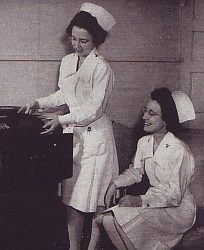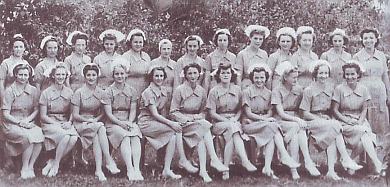Work Attire
.
Hospital Uniforms
.
| Prior the outbreak of war, the nurses were
issued a hospital uniform which consisted of a white, one-piece dress,
a white cap, white shoes and stockings and a blue wool cape.
The white hospital dress was a semi-fitting
uniform made of poplin with turnover collar, V-neck and full-length pleats
front and back. The front was buttoned, the sleeves were full-length with
turned-back double cuffs and the belt was detachable. This style of cotton
uniform had been in use with slight modifications since 1920. |
..... |
 |
.
|
|
.v |
In 1940, the length of the hospital
dress was reduced by 6 inches and a blue cotton crepe dress of the same
design as the white poplin uniform was added.
Colored crepe was deemed more practical for
places with limited laundry facilities as it was expected to be the case
in war times. Later blue seersucker replaced the blue cotton crepe.
The hospital dress could be worn with long
sleeves or short sleeves.

Army Nurses stationed at
the 12th Station Hospital,
Townsville, Australia, 1942
.
Left Picture:
Uniform, Nurse's, Blue Seersucker |
In the end of 1941, a new design for the completely
outmoded hospital uniform was submitted. The new dress was a form-fitting
garment, buttoned above the waist with three mother-of-pearl buttons. The
skirt held closed in front by seven concealed snap fasteners. The dress
had a yoke back and two patch pockets.
.
|
Note the epaulets of same
fabric which are sewn on completely.
|
. |
The hospital uniform was issued in the colors
white and powder blue. It was provided with long sleeves and short sleeves.
The white uniforms were made of poplin and the blues of seersucker. The
white uniforms were to be worn in the continental United States only. |
|
.. |
Uniform, Nurse's, Cotton
|
.
|
Uniform, Cotton Seersucker,
Nurse's
|
... |
In September 1942, a 4-ounce, brown and white-striped
seersucker fabric was selected for the hospital uniform to be worn in overseas
areas.
The new hospital dress consisted of a simple,
short-sleeved, wrap-around uniform with a tie belt. The wrap-around style
should allow ease in fitting and adjustment to the individual figure. The
elemination of all buttons further increased its practicality. Inside,
a tie string at the waistline was added to prevent that the skirt blow
open or slide apart. On duty, the seersucker uniform was worn with a matching
hospital cap.
A matching semi-fitted, collarless, one-button
cardigan style jacket could be worn over the dress provided the nurses
with a serviceable street outfit for warm weather.
A picture of the jacket is shown under
Service and
Dress Unifoms.
In the summer of 1944, the use of the seersucker
uniform was extended to Army nurses serving within the United States discarding
the white uniform. |
..
.
| In the summer of 1943, the urgent
need to develop a hospital uniform with trousers was noticed. For example,
such a uniform was necessary for nurses who were assigned to hospital ships
and trains where they had to climb ladders to attend patients in upper
bunks. Additionally, many nurses in overseas areas served in hospitals
where litters instead of beds were used.
A combination of shirt and slacks made of the
4-ounce brown and white-striped seersucker was developed for wear in warm
climates.
In early August 1943, the design of the shirt
and slacks was approved. At the end of the month both items were standarized.
On the basis of experience and field observations,
some slight revisions of the pattern were made later. For example, the
criticized fullness of the shirt's back was reduced, the sleeves were lengthened
and the slacks got more width through the hips. |
......... |
Shirt, Cotton, Seersucker,
Nurse's
and Slacks, Cotton, Seersucker,
Nurse's
|
..
Field Work Uniform
.
At the begin of the war, the Army had no suitable
uniforms for nurses who had to work under field conditions. Therefore,
these women were initially issued with men's coveralls and men's slacks
and shirts.
The first field fatigue uniform designed for
female Army personnel was a one-piece coverall made of olive-drab herringbone
twill. The coverall was soon replaced by a two-piece model made of herringbone
twill only, consisting of shirt and trousers.
.
| The shirt could be worn with collar open or
closed. It had two breast pockets with flaps to button. The trousers had
adjustable button closure on each side of the waistband. Field shoes with
or without leggings could be worn with this work suit. Headgear was the
olive-drab wool knit cap or the fatigue "daisy mae" hat.
Both, the herringbone twill coverall and the
two-piece variant were criticized as ill-fitting and unbecoming clothing.
On the one hand, the herringbone twill cloth was too hot for summer wear.
On the other hand, it was too thin to protect against cold winter weather.
Furthermore, it was too clumsy and too unsanitary for hospital work.
The herringbone uniform was issued in three
(later four) sizes only (Small, Medium, Large, X-Large). This caused many
problems with bad fitting. It even increased the risk of accidents.
Another problem was that the herringbone twill
fatigue garments were difficult to launder because of the weight of the
material and often did not dry over night. In addition, they tended to
shrink and faded out. |
.. |
Two-piece Herringbone Twill
Work Suit
|
|
Summer Work Uniform
|
... |
At the end of 1943, the need of khaki slacks
for female Army personnel serving in jungle environment and in warm climates
became more and more urgent. The seersucker slacks couldn't provide sufficient
mosquito protection and the HBT clothing also had proved insufficient.
Therefore, a summer work uniform consisting
of a khaki twill shirt and slacks was developed and finally approved in
the end of 1944.
The slacks suit was similar in design and material
to the one issued to Army men.
The summer work uniform should replace
the herringbone twill work clothing and the seersucker uniform in tropical
areas. |
.
Non Regluation Outfits
.
In the following, a few examples of non regulation
outfits which were worn by Army Nurses when no proper female work uniforms
were at hand.
Men's HBT Coveralls
with fatigue "Daisy Mae" hat
|
|
Wool Shirt with Men's
Wool Trousers
and white turban
|
.
Khaki Men's Shirt and Trousers
worn with M-1917 Helmet
|
|
For extra warmth:
Men's High Neck Sweater with
five buttons
|
.
.
[
I. Development ] [
II. Facts about the ANC ] [ III. Uniforms
] [ IV. Sources ]..
|
